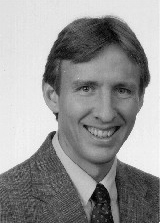

Todd Hubing
Associate Editor
Bigger companies with EMC departments often publish a set of EMC design rules for their product designers. Design rules can be a good thing, but there is a tendency to rely on them too heavily and sometimes incredibly poor design decisions are made in an attempt to comply with out-dated or just-plain-bad design rules.
As a case in point, the other day I came across the following EMC design rule in a corporate policy document on printed circuit board designs: “High-speed traces should not cross over gaps in a round plane.” Is this really a problem? How many circuit board designs employ round planes? This is a clear case of some well-intentioned EMC engineer making a simple observation and then drawing a grossly incorrect conclusion.
How many times have you seen this happen? For example, someone has an intractable radiated EMI problem. They work for days trying dozens of fixes. Finally somebody speculates that a “widget” is the source of the EMI. A ferrite is placed on the widget cable and the problem is solved. Everyone is happy and the problem solver is a hero. However the story does not end there. Somewhere is our hero’s mind a new fact is stored: “Widgets radiate.” And somewhere in the corporate database a new EMI design rule is registered: “Widget cables should have ferrites.” It doesn’t matter that widgets are low-speed devices with passive components. Evidence that widgets don’t radiate is dismissed by our hero, because it is contrary to experience. Lessons learned by experience outlast, and generally overrule, lessons learned from a textbook.
Maybe that’s the way it should be, but it is important to remember that lessons learned by experience can be wrong. People do not always draw the correct conclusions based on their experiences. This is particularly true when the experience is an EMI test marathon and the primary goal is to fix the product rather than to understand the problem.
Which brings us back to the rule about traces crossing gaps in a round plane. This is evidently a rule based on someone’s experience. They may have observed that their boards with traces crossing gaps in rectangular planes did not have EMI problems. On the other hand, boards with traces crossing over a gap in a round plane may have radiated significantly. A design rule was born.
Nevertheless, modeling of this phenomenon reveals that the shape of the plane should have very little effect on the EMI. True, the size and shape of the plane affect the resonances. It’s possible for a change in the plane’s shape to have an effect on EMI due to alignment of clock and resonant frequencies. However, there is no reason to believe that round planes (in general) should be any worse than planes with other shapes.
This rule should be scrapped. In fact, all design rules based on experience that cannot be justified using thoughtfully constructed and experimentally validated models should be scrapped. Companies are spending too much money doing stupid things like putting ferrites on widget cables and avoiding round planes. Unsubstantiated and out-of-date EMC rules-of-thumb are robbing our world economy of billions of dollars every year! It’s time to take a stand. EMC engineers of the world unite! Just say NO to unvalidated design rules! Show me the model!
[Note: Of course, it’s possible that the rule I saw was a misprint. Perhaps it was supposed to say, “High-speed traces should not cross over gaps in a ‘ground’ plane.” In that case, never mind.]
John Clarke reports that the April meeting of the Central New England chapter featured “A Review of Taiwan’s BCIQ EMC Approval Process CNS 13438" presented by Peter Boers, US National Committee, Technical Advisory Group for CISPR/G. The speaker provided a brief overview of the implementation schedule of CNS 13438 and the change in agency name from BCIQ to BSMI. His presentation was followed by a discussion of the differences between this standard and CISPR 22.
The May meeting featured James Press of National Technical Systems, who gave a presentation titled: “Overview of Lightning and Other Transient Phenomena.” The presentation provided an overview of the physics of lightning and the composite waveforms used to simulate the effects of lightning. The speaker described commercial FAA, military, and telecommunication requirements for lightning hardness. The following specifications were addressed: ANSIC62.41, EN61000-4-5, SAE-AE4L, DO-160 and GR-1089-CORE.
CNEC Officers Elected for 1999/2000 were: Chairperson and Secretary - John Clarke, Vice Chair - John Luchini, and Vice Chair - Lee Hill.
Prof. Salvatore Celozzi reports that the Central & Southern Italy chapter hosted two very interesting presentations on June 4th. The presentations were given by Distinguished Lecturer, Dr. Elya Joffe, of KTM, Tel Aviv. About 25 persons attended the high-level presentations in the ancient cloister of the Faculty of Engineering of the University of Rome “La Sapienza”.
Elya’s lectures were respectively on “Grounding and Grounding Implementation in PCBs” and on “High-Speed Transmission Lines in PCBs”. He got the attention of the audience not only with many examples from the real world but also by means of very funny stories (both EMC-related and otherwise!). At the end, everybody was enthusiastic about the content and the way the presentations were given.

Elya Joffe giving a presentation to the Central and
Southern Italy Chapter.
The Chapter also contributed to the promotion of a two-day meeting on “EMC-related safety issues in transportation systems” hosted by the University of L’Aquila and organized by professors M. Feliziani and R. De Leo. The meeting was held on June 23 and 24.
Ray Klouda reports that this spring has been exciting for the Chicago EMC Chapter. Antenna Calibration Methods were discussed at their March meeting which was held at Underwriters Laboratories in Northbrook. Mike Howard of Liberty Labs and Dale Sventanoff of Lindgren RF Enclosures presented their thoughts regarding the latest improvements in the field of antenna calibrations. By far the highlight of this spring was their first Chicago Chapter EMC Mini Symposium that was held May 24 at the Holiday Inn in Itasca. Over 100 people attended this event. Twenty-two companies exhibited. This one-day extravaganza featured “Legal Issues in EMC” presented by Marshall Miller of Baise, Miller, and Feer and Roosevelt Nesmith of Patterson, Belknap, Webb and Tyler. These two gentlemen gave a riveting account of EMC liability issues that are beginning to surface in the courts and things that EMC engineers need to consider. The program was rounded off with presentations including “Introduction to EMC” presented by Tom Braxton of Lucent Technologies and Derek Walton of LF Research, “Significance of Laboratory Accreditations” presented by Mirko Matejic of Foxboro Co. and “EMC Testing Issues” presented by Pat Malloy of Amplifier Research and Dr. Mike Foegelle of ETS. A special award was presented to Tom Braxton of Lucent Technologies at our awards banquet to honor Tom for his contributions and dedication to the Chicago Chapter. His efforts are much appreciated. Two drawings were held at the conclusion of the symposium. Carla Robinson of 3COM presented a 3COM Palm Pilot to Joe Khammyvong. An HP meter went to Ken Pagenkopf. The event was a tremendous success. Many positive comments were received.
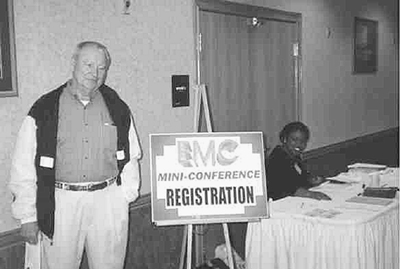
Rod Foley of EIA and Carla Robinson of 3COM at the registration table.
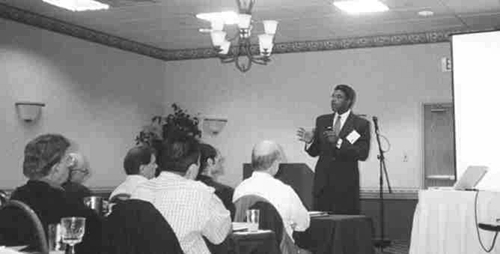
Roosevelt Nesmith of Patterson, Belknap, Webb and Tyler presenting Legal Issues in EMC.
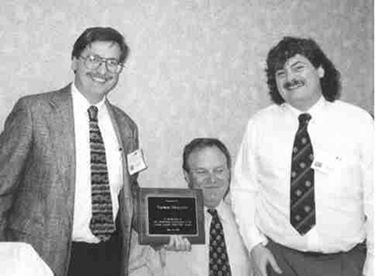
Tom Braxton (left) receives his award for his contributions
to the Chicago
chapter from our chair Derek Walton (far right).
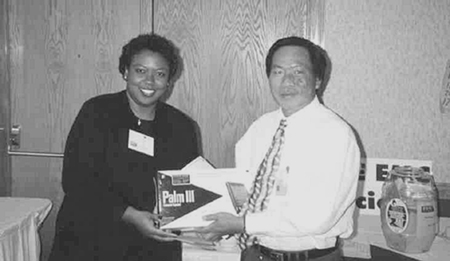
Carla Robinson presents the grand prize to Joe Khammyvong.
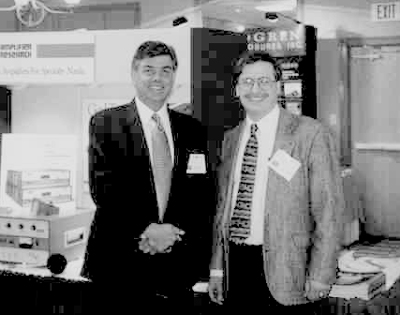
Frank Krozel of Electronic Instrument Associates (left) and
Tom Braxton of
Lucent Technologies in the exhibit area.
The German Chapter will hold its annual meeting in Frankfurt, VDE Haus, Stresemannallee on November 17th, 1999 at 10:00am. Please confirm your participation via e-mail to heyno.garbe@ieee.org.
The Israeli IEEE EMC Chapter held its first chapter meeting of 1999 in Haifa. This was the first time ever that a Chapter meeting was held in Haifa, in the North of Israel.
The meeting - a full day workshop on EMI from Circuits to Systems, was held jointly with the Israel Association of Engineers and Architects (AEAI) and was hosted by them in their facilities. Many thanks to Dr. Josef Pecker, a member of the Chapter and the Society, for his dedicated assistance in the organization of the Meeting. Special thanks also to our “Angel” for providing the “Angel” support for refreshments and a light lunch for the participants.
Participation in the meeting was great! Over 60 attendees, most of whom were IEEE members. Others have requested application forms for the IEEE and the EMC Society, and we hope to see them as members, soon.
After a short welcome by the EMC Chapter Chair, Elya B. Joffe, a welcome address on behalf of AEAI was given by Mr. Dror Ken-Dror, Chairman of the Electronics and Electrical Engineering Society of the AEAI in Haifa.
Following the welcome address, elections for 1999 officers were held. The following people were elected: Chairman - Elya B. Joffe, Vice Chairman - Moshe Netzer, Secretary - Eli Recht, Student Activities - Prof. Jacob Gavan, Technical Activities - Dr. Alex Axelrod. Good luck to the elected officers, and thanks to the retiring officers.
Following the elections, the following technical presentations were given:
On July 4-5, 1999, two full day tutorials on High Speed Digital Design of PCBs were held in Tel-Aviv, in conjunction with ILTAM (the Israeli Consortium of High Technology Users in Electronics). The tutorials were presented by Dr. Istvan Novak of Sun Microsystems.
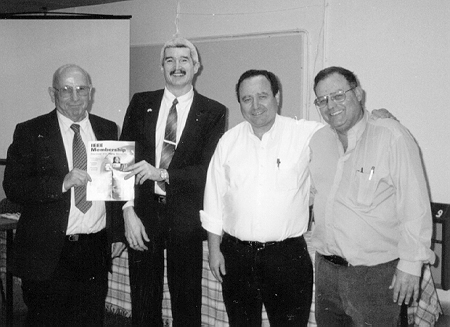
The Israel EMC Chapter recently elected new officers, including
(R-L) Eli Recht,
Secretary, Moshe Netzer, Vice Chair (returning to office after a sabbatical),
Elya B. Joffe, Chapter Chairman (again!), and a “New Chapter Member”
(holding the inevitable IEEE registration form which was just completed).
Over 140 participants turned out for the first day to hear presentations on “First Order Effects on PCBs,” “Second Order Effects on PCBs,” and “Power Distribution Systems on High Speed PCBs.”
On the second day, a smaller group of interested parties attended a more “cozy” session with Dr. Novak for the discussion of High Speed Design and Analysis Tools. Many, many thanks to Dr. Novak, who agreed to come to Israel, for 2 days only, including the 4th of July, for this special seminar.
Responses to the “Request for Proposal” (RFP) for selection of the organizing company for the 2003 Symposium were received in November. The selected company is ORTRA. ORTRA is extremely experienced in the organization of IEEE Symposia, and assisted in the organization of the 1992 IEEE Regional Symposium on EMC, which took place in Tel-Aviv, Israel.
Sponsorship (or participation) has been approved already by the IEEE EMC Society, IEEE Region 8, IEEE Israel Section, Israel IEEE EMC Chapter, and the Israel URSI National Committee. Future reports will continuously update the activities and preparations for this great and exciting event. Stay Tuned!!!
Additional Chapter meetings and activities are scheduled for1999. Information on them may be found in the Web Sites of the Israel IEEE Section at https://www.eng.au.ac.il/~ajw/ieee.html.
The Israel EMC Chapter wishes to extend a welcoming hand to all colleagues, EMC engineers and engineers in related fields, from our neighboring countries, in particular Jordan, Egypt, and the PA, and invite them all to hold joint activities, conference meetings, etc. In particular, the Israel Chapter invites engineers from our neighboring countries to participate in our chapter meetings, and will hold such meetings in English for the benefit of our guests.
On June 24th, the Orange County chapter welcomed Steve Watkins and Mike Morino of Cassper Instrumentation Systems, along with Ed Nakauchi of SARA Inc. to the June Chapter meeting. The trio demonstrated CIS’s newest system, a two-channel spectrum-analyzer-like system, which has the ability to simultaneously and synchronously make two RF measurements. The system’s amazing ability to identify and cancel out ambient signals was demonstrated, along with the unit’s unique capability to localize and even pinpoint the source of EMI within a circuit design. These features are made possible by a combining the latest in EMI receiver design and cutting edge DSP technology. The presentation was well received, with even the most seasoned of EMI engineers walking away from the presentation very impressed. Although a smaller than usual meeting, with 16 attendees, the presentation ended up being one of the most exciting of the year.
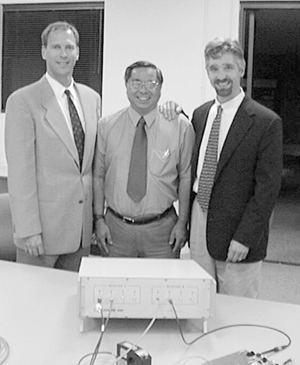
Stephen Watkins of CIS, Ed Nakauchi of Sara Inc., and
Mike Morino of CIS with the CASSPER System (left to right).
This fall The Orange County Chapter of the IEEE EMC Society is hosting EMCFest ’99, a one-day tutorial featuring some of the top speakers in the EMC community. Scheduled speakers include Dr. Howard Johnson, Mr. Lee Hill, and Mr. Daryl Gerke. Topics to be presented include High Speed Digital Design for EMC, Standards Activity, and EMC Troubleshooting Techni- ques. Vendors from the EMC community will also be on hand with the latest information on EMC mitigation products and test equipment. For more information, please contact Randy Flinders at (714) 513-8012 or r.flinders@ieee.org.
[Thanks to Henry Benitez, chair of the Oregon Chapter for submitting the following report.]
Summertime is here and we are ready to enjoy it. We had great speakers at our monthly chapter meetings and events all year long. Chapter speakers included Bob Dockey, Chris Kendall, Dr. Howard Johnson, Dick Ford, Hans-Peter Bauer, Joe Butler, Ken Javor, and Jose Perini. The April EMC ‘99 Oregon Colloquium was a grand success once again. Vendor participation was excellent and has been a major contribution to these local events. Colloquium speakers included Henry Benitez, Greg Kiemel, Don Bush, Mark Montrose, and Doug Smith.
At our May Chapter meeting, Jose Perini and Ken Javor gave excellent presentations on RF conducted immunity and RF fields immunity techniques. The gentlemen added excitement to the meeting by sparring one another on the issue of correlatability between the two methods when evaluating long cables in the frequency range below 80 MHz. The views of both speakers were quite valid and very well respected. We considered the debate a draw!
We started off this summer with an EMC Summer Social on July 26. We had 70 people join our picnic! In July we will help the Oregon IEEE Section celebrate via a “Portland Spirit” cruise on the Willamette river. 200 IEEE affiliates are expected! In August we expect to show up in numbers to the Seattle ‘99 EMC Symposium.
Included are pictures of the EMC ‘99 Oregon Colloquium, recent chapter meetings and the EMC Summer Social Picnic.

Charlie Tohlen of Tektronix (L) prepares his hot dog at the
Oregon summer
social while Jerry Page of Northwest EMC promotes the IEEE EMC
Symposium in Seattle. Who else would take an advance program to a picnic?!
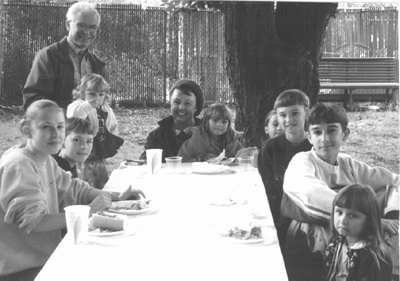
Oregon Chapter member Orv Olson (standing) attended the summer
social
with his wife and eight of his 18 grandchildren - all future EMC engineers!
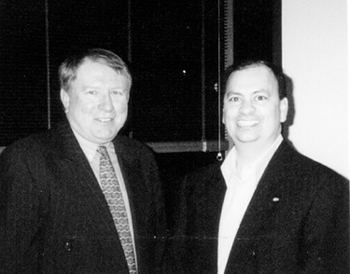
At the March meeting of the Oregon Chapter, Joe Butler (L)
of the
Chomerics Division of Parker Hannifin, spoke on shielding effectiveness
and standards. He is joined by Chapter Chairman Henry Benitez of Tektronix.
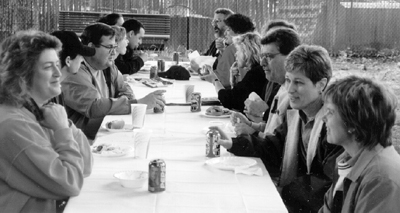
Conversations at the Oregon summer social included the chapter
officer
wives suggesting that they organize next year’s picnic.
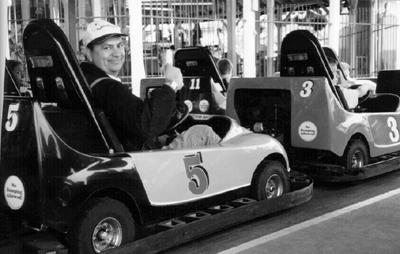
The amusement park at the Oregon chapter summer social brought
out the
“kid” in several members, including Chapter Chairman, Henry Benitez of Tektronix.
Go Henry go!

Speakers Jose Perini and Ken Javor shake hands after an extensive
debate
over the correlatability of two test methods at the May Oregon Chapter meeting.
The Chapter called it an exciting “draw.”
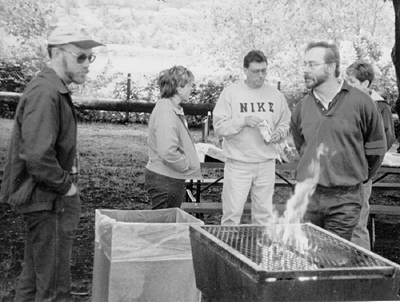
Dave Crawford of Tektronix (L) suggests adding liquid oxygen
to the charcoal
at the June summer social organized by the Oregon chapter.
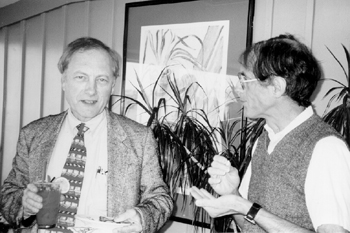
The Oregon Chapter held an EMC Colloquium and Exhibition
on
April 12 in Portland. At the pre-party for out-of-towners, speakers
Don Bush (L) of dBi Corporation in Winchester, Kentucky and
Doug Smith of Auspex Systems in Santa Clara, California, catch
up on the latest.
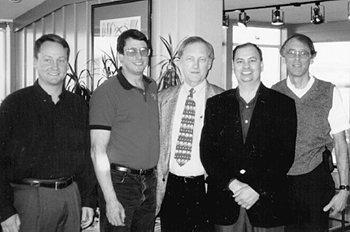
The speakers at the Portland EMC Colloquium included (L-R)
Greg Kiemel of Northwest EMC, Mark Montrose of Montrose
Compliance Services, Don Bush of dBi Corporation,
Henry Benitez of Tektronix, and Doug Smith of Auspex Systems.
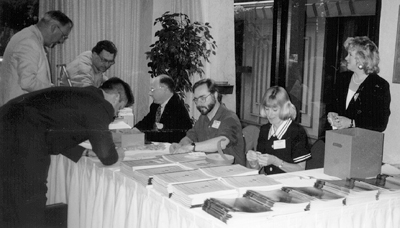
The registration crew is shown hard at work at the Portland
EMC Colloquium.
The able assistants seated behind the table are (L-R) Dan Arnold of
Underwriters Laboratories, Charlie Tohlen and Jamie Moritz, both of Tektronix.
Standing is Ann Tohlen who helped her husband at the Colloquium.
The Phoenix Chapter of the IEEE EMC Society sponsored a one-day colloquium on EMC at the Double Tree La Posada Resort in Scottsdale, Arizona on May 3, 1999. Six world-renowned experts in EMC presented talks and answered questions on EMC requirements, electrostatic discharge, circuit board layout, testing and troubleshooting techniques. These experts included Dan Hoolihan, the president of the IEEE EMC Society, and Henry Ott, the keynote speaker for the event. Many of the people that attended the colloquium never get to attend the EMC Society’s annual IEEE EMC symposium so this event provided them with a good source of education. Twenty-seven vendors offered exhibits of their products and fielded questions from over 80 attendees. This provided an excellent opportunity for local EMC engineers and technicians to learn about the latest in test equipment, EMC control products, and EMC prediction software.
Six invited technical papers were presented during the one-day colloquium. Dan Hoolihan, TUV Product Service, provided an overview of EMC requirements. This talk was beneficial to both the novices and the experts in the audience. Especially enlightening was the explanation of the how the new European Union RTT&E Directive will allow manufacturers of radio transmitters to self-declare to harmonized standards without the need for a Notified Body. This apparently caught the FCC by surprise since they didn’t think the EU was going to take such a liberal approach.
Bill Ritenour, EMC Compliance LLC, provided an excellent tutorial on ESD including a discussion of the various standards and information on mitigation techniques. Bill also put on an ESD demonstration during the reception that followed the talks.
Scott Roleson, Hewlett-Packard Company, shared his techniques to evaluate emissions from products without the need for expensive shield rooms or open area test sites. The attendees enjoyed his analogy of finding the optimum set of EMI fixes to that of fixing the leaks on a tin can while blind-folded. You don’t know which areas are just dents and which are real holes. Therefore, you keep adding fixes until the can stops leaking and then remove them one at a time until only the necessary fixes are left. Henry Ott provided empirical data on the inductance of ground planes and contrasted his data with that of some theoretical work by Holloway and Kuester. We learned that the ground plane is low inductance except where the current bunches together near the board via. His empirical data showed that the inductance of the ground plane approaches that of a single trace (about 5 to 10 nH/cm) when within a centimeter or so of the via. Henry also demonstrated that small holes have a negligible effect but slots can be a major contributor to ground plane inductance.
Daryl Gerke, Kimmel Gerke Associates, provided some excellent techniques on troubleshooting conducted and radiated immunity problems. He explained that you must first diagnose the problem by gathering and critiquing data using differential diagnosis as is done in the medical field. Then diagnostic tests are performed as appropriate such as using an ESD gun or mobile and hand held radios to determine the coupling means for the problem. Finally, appropriate fixes are tried and the tests are repeated to verify that the fix is effective.
Bill Kimmel, Kimmel Gerke Associates, enlightened us with troubleshooting techniques for radiated and conducted emissions. Bill recommended to work from the outside in by starting with external cables and shields and progressing inside to internal cables, grounding and the circuit boards. Bill also echoed Scott’s suggestion to leave all fixes in until the goal is achieved. Then the fixes can be removed one by one.
The Phoenix Chapter of the EMC Society would like to thank all of the speakers, the vendors, the chapter officers, and the attendees for making this a very successful event. A very special thanks needs to go to Janet O’Neil, Lindgren RF Enclosures, for her exceptional work on coordinating the event.

The Phoenix Chapter sponsored EMC ‘99: A Colloquium and Exhibition
on EMC Pre-Compliance Testing Problems and Solutions. Shown at the
pre-party for out-of-towners before the event are Dave Bernardin of TUV
Product Service in San Diego and Dean Ghizzone of Northwest EMC in
Newberg, Oregon.
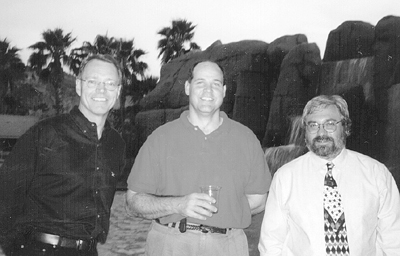
Enjoying the Phoenix chapter hospitality poolside at the
DoubleTree
La Posada Resort are Leo Smale of Kalmus, Mark Prchlik of BMI, and
Mike Hoen of Honeywell.

The organizing committee for EMC ‘99 Arizona included (L-R),
Harry Gaul of Motorola,
Treasurer, Janet O’Neil of Lindgren RF Enclosures, Vice-Chair, Terry Donohoe
of Honeywell,
Registrar, and Daryl Gerke of Kimmel Gerke Associates, Chair.
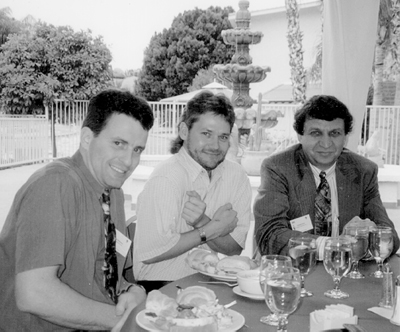
The luncheon held during EMC ‘99 Arizona was outside on the
resort’s patio.
Who would have thought on May 3 that the temperatures would drop to the low
60s?
Shivering are (L-R) Todd Robinson of CKC Labs, Tom Lindgren of
BF Goodrich Aerospace, and Vladimir Kraz of Credence Technologies.

It’s an all-star line-up of speakers that contributed to
the success of EMC ‘99
Arizona. Seated (L-R) are speakers Bill Ritenour of EMC Compliance LLC and
Scott Roleson of Hewlett-Packard. Standing (L-R) are speakers Dan Hoolihan of
TUV Product Service, Henry Ott of Henry Ott Consultants, Bill Kimmel and
Daryl Gerke, of Kimmel Gerke Associates.
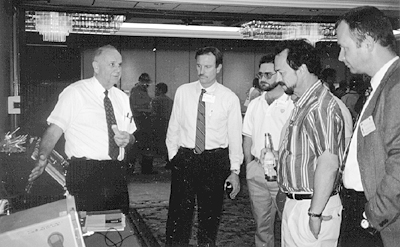
Demonstrations of the material presented during EMC ‘99 Arizona
were held
during the reception following the technical program. Bill Kimmel (L)
attracted an audience for his demonstration on conducted emissions
troubleshooting techniques.
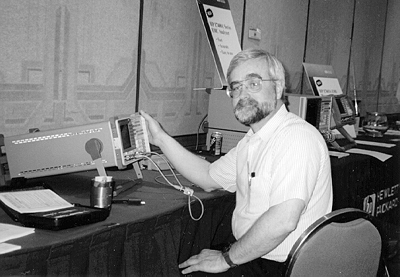
The ever-popular Scott Roleson readied his demonstration
on bench-top
radiated emissions test techniques just prior to the EMC ‘99 Arizona reception.
[Thanks to Lyle Luttrell for sending in this report from the Rocky Mountain Chapter.]
We knew the topic of PCB Design would be popular; we were pleasantly surprised that we underestimated the response we would have for our April 21 program on “PCB Design Techniques for Signal Integrity and EMC Compliance”. Following a pizza lunch sponsored by TUV Product Service, 71 people filled the meeting room at StorageTek in Louisville, CO for a very interactive four hour session with EMC Society Distinguished Lecturer Mark Montrose of Montrose Compliance Services! Thanks to Mark, we have a better understanding of the linkage of signal integrity and Electromagnetic Compatibility, and many of the issues that the design team needs to consider with the trends of today’s technology.
Mark introduced the subject of signal integrity, which is a concern for logic designers, and its relationship to the field of EMC. The PCB designer, EMC engineer, and other design team members have a common goal of ensuring that a functional product is developed for corporate revenue. Signal integrity is a complex issue, and is hard to understand or analyze without advanced engineering education, experience or expensive simulation tools, however the fundamentals are closely related to EMC. While signal integrity is a time domain issue, EMC engineers typically deal with the frequency domain.
Mark’s presentation helped EMC engineers gain knowledge for understanding complex digital designs, related to EMC compliance, along with signal integrity for high-speed, high technology systems. He also raised an awareness of the mechanisms of how EMI is created and propagated within a PCB to help us understand control principles. Mark discussed basic printed circuit board concepts in both the time and frequency domains; this format allowed engineers to understand fundamental concepts and techniques that can be incorporated during the design and layout of a PCB for both signal integrity and EMC compliance. Finally, Mark provided a sampling of design and layout techniques that have a proven track record of success, providing attendees with some valuable information to use on their next project.
Our 1999 Regional Symposium on EMC held May 18th at the Holiday Inn Northglenn was a great success! The Holiday Inn provided an excellent venue for our expanded program. The Technical Program, expanded to a full day event, featured ten papers of exceptional quality. The Workshops and Tutorials included five presentations and technical exhibits by twenty-seven regional and national firms provided attendees with the opportunity to check out the latest products and services for EMC design and testing. Participation by the Colorado Product Safety Technical Committee helped round out the program.
Our attendance of 125 was more than double the event attendance of recent years. Attendees, presenters and exhibitors agreed that this was an exceptional program of value to EMC and Product Safety professionals. The symposium included a continental breakfast and superb buffet lunch for all registrants, sponsored by Fischer Custom Communications, National Technical Systems, Chomerics, Amplifier Research, and EMC Test Systems. We did not hear from anyone who left hungry after that lunch!
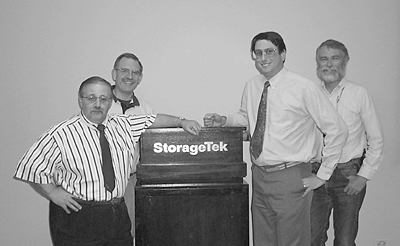
Rocky Mountain Chapter officers welcome Mark Montrose to
StorageTek.
Left-right are Vice chair Charles Grasso of StorageTek, Chapter Chair
Lyle Luttrell of Breece Hill Technologies, Lecturer Mark Montrose of
Montrose Compliance Services and Secretary Bob Reinert of StorageTek.
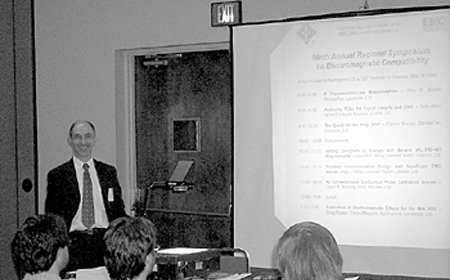
Technical Program Chair Bob German of German Training & Consulting
welcomes
attendees to the EMC technical session at the Rocky Mountain Chapter’s Regional
EMC Symposium.
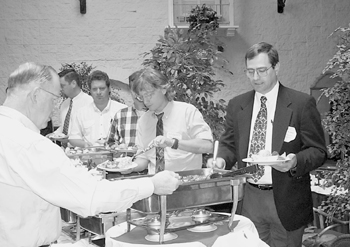
Reid Gardner of Hewlett Packard, Dr. Chris Holloway of ITS/Dept.
of Commerce and Barry Wallen of Criterion Technology help themselves
to the terrific buffet lunch at the Rocky Mountain Chapter’s Regional EMC Symposium.
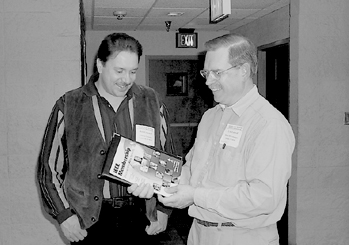
Chapter Chair Lyle Luttrell of Breece Hill Technologies,
right,
welcomes Bob Cresswell of Criterion Technology to IEEE EMC
Society membership. Bob was one of several new members to join
IEEE during the Rocky Mountain Chapter’s Regional EMC symposium.
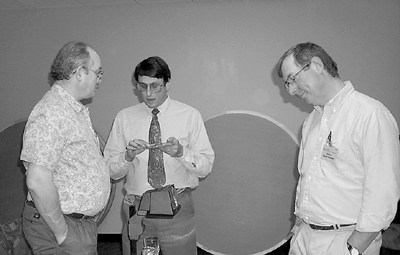
Mark Montrose, center, provides insight on a technical problem
with H. Holmes,
StorageTek and Brent DeWitt, Datex-Ohmeda at the April meeting of the Rocky
Mountain Chapter.
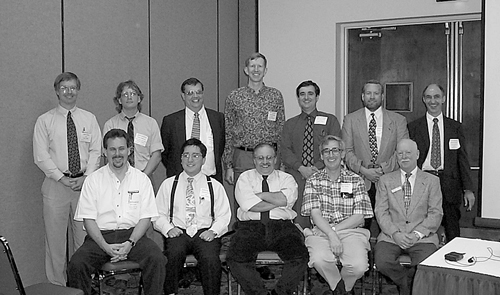
Tutorial and Workshop presenters at the Rocky Mountain Chapter’s
Regional EMC Symposium:
Front row: Eric Lord, David Novotny, Charles Grasso, Otto Buhler,Ron Duffy.
Rear: Bob Johnk,
Chris Holloway, Ed Reilly, Monrad Monsen, Ray Perez, Greg Rigden, Bob German.
A complete technical program is available at our web site, with many technical papers available for download. The site also includes links to exhibitors and sponsor web sites. The site address is https://www.ewh.ieee.org/r5/denver/rockymountainemc.
Thanks to everyone that made this a great success! Special thanks to symposium committee and helpers: Lyle Luttrell, Chas Grasso, Bob German, Tony O’Hara, John Stadille, Bob Reinert, Danny Odum, Bill Bryant, and Richard Georgerian.
In other news, the Rocky Mountain EMC Society Chapter was selected as the 1999 recipient of the Society Chapter of the Year award by the IEEE Denver Section. The award recognizes the outstanding services provided by the Chapter to its membership. Lyle Luttrell, chapter chair, attended the Denver Awards Banquet on May 19 to accept the award, which includes an engraved plaque and an honorarium of $100 for the chapter.
The Rocky Mountain Chapter web site is regularly updated with information on past and future programs with links to other sites of interest for EMC engineers. Our meeting program will resume in September; as meeting information is available it will be published first on our Chapter web site https://www.ewh.ieee.org/r5/denver/rockymountainemc.
The San Diego Chapter held a meeting & BBQ on June 16th. Dave Bernardin, chapter chair, reports that they had a great BBQ at the Hewlett-Packard office on Aero Drive. Steak and salmon were served with potato salad, chips and cold drinks. There were three terrific speakers from CASSPER Instrumentation Systems, Inc. Mr. Stephen Watkins CEO/President, Mr. Mike Marino, Vice President Engineering and Mr. Ed Nakauchi, EMC Consultant SARA, gave a presentation on “EMI Ambient Cancellation and Source Localization Technology.”
Mark Montrose reports that the Santa Clara Valley Chapter concluded its 1998-1999 season with two presentations prior to the annual summer break. With a large attendance at the April 13th meeting, Dr. Gary Haussmann of Silicon Graphics Inc., discussed “Solving Real World EMC Problems Using FDTD Modeling Code.” An analysis of how the FDTD modeling technique can be effectively used to solve real world EMC problems was presented. Applications ranged from time-domain signal integrity problems, commonly found in high speed circuit design, to the more traditional frequency-domain EMC problems associated with enclosure and printed circuit board resonances, radiation through apertures, and crosstalk.
The May meeting has always been a special one for the chapter, as election of officers occur for the following year. In addition, it has become an annual event for Dr. Zorica Pantic-Tanner, Director of the School of Engineering, San Francisco State University (SFSU) to have students present results of ongoing research projects in EMC and signal integrity (SI). The university has received numerous equipment donations from industry, along with student research grants that have been put to excellent use. EMC concepts have been integrated throughout the EE curriculum, and expanded laboratory capabilities have given students the opportunity to pursue a high caliber of EMC and SI research. Topics presented include the study in time/frequency domain analysis of PCB crosstalk, minimization of signal integrity waveform distortion using transmission line terminations, and radiated field coupling into shielded enclosures with apertures.
The chapter took the month of April “off” and did not hold a meeting as chapter members were encouraged to travel to Portland to support the regional EMC colloquium held there on April 12.
On May 25, the chapter reconvened at the Hyatt Hotel in Bellevue to hear two distinguished speakers, Dr. Jose Perini and Mr. Ken Javor. The speakers presented differing viewpoints on the validity of substituting conducted immunity (CI) approaches for traditional radiated immunity (RI) techniques. Both Dr. Perini and Mr. Javor have investigated and published results on this topic over the last decade.
Dr. Perini’s analytical work and numerical simulations conclusively demonstrated the following:
Mr. Javor stated that when cables are electrically long there is no way to inject a conducted signal in such a way as to replicate the precise pattern of standing waves induced by a radiated field. He also stated that such a degree of accuracy was unnecessary. Mr. Javor made the following points:
Mr. Javor’s position is that there has to be a linkage between the CI and RI tests since the CI test is a means for demonstrating compatibility with an electromagnetic field environment.
This was the first time a chapter meeting featured two speakers who presented different perspectives on the same topic. It was quite a spirited and thought provoking evening! The format is highly recommended to other chapters.
The Seattle chapter wisely decided to cancel the traditional summer social meeting as the chapter officers and several chapter members would be “knee-deep” in planning a slightly larger summer social - the 1999 IEEE International Symposium on Electromagnetic Compatibility in downtown Seattle.

The Seattle Chapter treated its members to two outstanding
speakers AND a delicious three-course
meal at the May meeting. What a way to close out the regular monthly program
of meetings from
September through May! Celebrating the intellectual and culinary feast are (L-R)
speaker
Jose Perini, Kitty Tam, Leo Smale, and speaker Ken Javor. Kitty represented
Northwest EMC
while Leo represented Kalmus, the two companies who generously sponsored the
dinner.

Southeastern Michigan Chapter members attended the April
26-27
SAE TopTec on Automotive EMC in Novi, Michigan. Scott Lytle and
Mario Mifsud manned the Eaton table top display. Can you spot
EMCS Board member Kimball Williams in this photo?

EMC Society member Poul Andersen of DaimlerChrysler and Kin
Moy
of Delphi Automotive Systems/Packard Electric were part of the
organizing team for the SAE’s only technical conference devoted exclusively
to EMC.
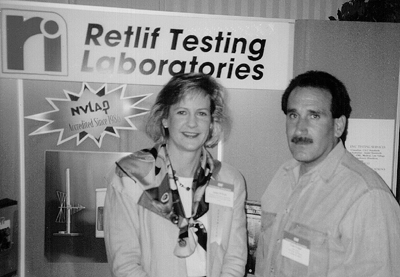
Tom Volpe of Retlif Testing Laboratories supported the SAE
TopTec on EMC.
Janet O’Neil dropped by his table top display to see what’s new with EMC automotive
testing.
Stellan Stenmark, Secretary of the Sweden chapter reports that the topic of their April meeting was EMC –reliability, a necessity for vehicle technology. The meeting was held at Volvo in Gothenburg and it was attended by more than 40 people. After ordinary proceedings, the attendees had the honor of listening to Dan Hoolihan, President of the IEEE EMC Society.
Dan talked about the IEEE and the EMC Society in particular. He gave a very interesting historical review of the organization from the start at 1884 with AIEE to the IEEE organization of today with a number of Regions and Societies. After lunch, Dan presented the status of the new proposal for ISO Guide 25.
Hakan Berg of Volvo Car Corporation presented EMC Aspects of Future Vehicle Electronics. His presentation provided an overview of the complexity of future vehicle technology. It also highlighted the challenge of intrasystem EMC.
Bjorn Bergqvist of Volvo Car Corporation presented The Car – A Society in Miniature. His presentation gave everyone a good understanding of the necessary functions needed in a modern cars and cars of the future.
Jonas Bergqvist of Saab Automobile AB gave a presentation on EMC Experiences with the Implementation of the CAN-Bus. After defining a CAN Bus he provided an overview of the application in a Saab 9-5 and also showed the physical layer implementation. The EMC approach was given particular attention and design and validation requirements were presented. A simulation method for stub analysis was discussed and a detailed description of the EMC/ESD filter design was given.
Dag Bjorklof, chair of the EMC Sweden chapter, gave a presentation on Some Experiences with Round Robin Tests and summarized the meeting. Special thanks go out to the host, Volvo Car Corporation, and to Daniel Hoolihan.

EMC Society President Dan Hoolihan attended the meeting held
by the Sweden
Chapter of the EMC Society. He is welcomed at the meeting by the curent chapter
officers including (left to right) Stellan Stenmark, Per-Olof Eriksson, Jan
Carlsson,
and Dag Bjorklof.
Return to Table of Contents...